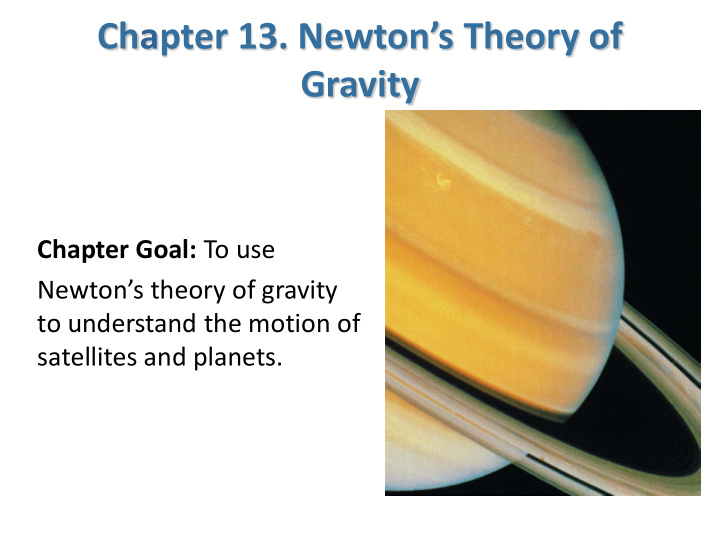



Chapter 13. Newton’s Theory of Gravity Chapter Goal: To use Newton’s theory of gravity to understand the motion of satellites and planets.
Geocentric Model of Ptolemy Earth at the center of the universe From ancient Greeks to middle ages in Europe Epicycles as orbits
Copernicus (circa 1543) Copernicus adopted a model with sun at the center Now the orbits were circular
Tycho and Kepler Between 1570 – 1600, Tycho compiled most accurate astronomical observations known to that date Tycho’s young assistant Johannes Kepler analyzed the data for many years and made Three key observations.
Kepler’s Laws 1. Planets move in elliptical orbits, with the sun at one focus of the ellipse. 2. A line drawn between the sun and a planet sweeps out equal areas during equal intervals of time. 3. The square of a planet’s orbital period is proportional to the cube of the semimajor-axis length.
Ellipses
Newton’s Law of Gravity Newton’s key contribution was the realization that the force of the sun on the planets was identical to the force of the earth on an apple. Newton proposed that every object in the universe attracts every other object.
Newton’s Law of Gravity The constant G , called the gravitational constant . In the SI system of units, G has the value 6.67 10 −11 N m 2 /kg 2 .
Little g and Big G Suppose an object of mass m is on the surface of a planet of mass M and radius R . The local gravitational force may be written as where we have used a local constant acceleration: On earth near sea level it can be shown that g surface = 9.80 m/s 2 .
Gravitational Potential Energy When two isolated masses m 1 and m 2 interact over large distances, they have a gravitational potential energy of where we have chosen the zero point of potential energy at r = ∞, where the masses will have no tendency, or potential, to move together. Note that this equation gives the potential energy of masses m 1 and m 2 when their centers are separated by a distance r .
Orbital Energetics We know that for a satellite in a circular orbit, its speed is related to the size of its orbit by v 2 = GM / r . The satellite’s kinetic energy is thus But − GMm / r is the potential energy, U g , so If K and U do not have this relationship, then the trajectory will be elliptical rather than circular. So, the mechanical energy of a satellite in a circular orbit is always:
Recommend
More recommend